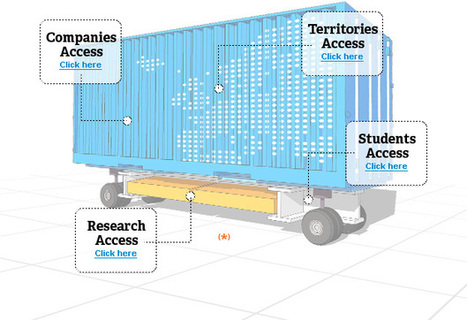 Your new post is loading...
 Your new post is loading...
Well here’s some news you probably didn’t see coming: Taiwanese electronics manufacturer Foxconn is rumored to be planning a manufacturing plant in the United States according to Taiwan’s Digitimes. The company, which has most of its factories in China at present, produces many of the most popular electronic devices (including Apple devices) and employs a huge number of workers.
Via Chain Media
Japanese e-commerce giant Rakuten has made another European acquisition after it bought up French logistics firm Alpha Direct Services (ADS) in an undisclosed deal [PDF] that it says will bolster its global Web retail businesses, which includes France-based PriceMinister – bought in 2010 for $255 million.
Via Peta Heinrich
Event Ground Global's software, Manifest Optimization Solutions (MOS), helps corporate meeting planners reduce costs by 30% on average.The software, Manifest Optimization Solutions (MOS), helps corporate meeting planners reduce costs by 30% on average. It also helps reduce the amount of carbon emitted into the atmosphere by chauffeured cars, taxis and other vehicles that transport people traveling to meetings back and forth from the airport. That’s especially good news as organizations continue to plan and hold more meetings as the economy recovers. According to American Express Meetings & Events, companies held more meetings in 2011 than a year earlier and have increased budgets for meetings in 2012. What’s more, higher travel and meeting costs are anticipated. Event Ground Global developed MOS to help corporate meeting planners who manage transportation for 20 to 4,000 people save time. “MOS users report saving 60% to 80% of their manifest management time," says Frank Schnur, Chief Marketing Officer. "The time savings come from automating the process, automating the grouping of passengers and integration with reservation systems. MOS gives meeting planners more time to focus on saving money and creating a great meeting." He explains that meeting planners typically prepare a manifest or schedule for ground transportation to and from meetings using a spreadsheet, a manual and inefficient process.....
Why are purchasers and suppliers so often disappointed by the results of strategic sourcing, and how can they stop the value leaking out of hard-won contracts?..... Collaborative Approach Procurement organisations that employed a collaborative (versus an adversarial) approach to negotiations reported greater satisfaction with their negotiated agreements and the value realised from those agreements. Of the top 10 per cent of buy-side study participants in terms of self-reported value realised during contract implementation, 63 percent described their negotiations as “highly” or “somewhat” collaborative. Those employing a collaborative negotiation approach reported more positive working relations with suppliers, fewer unexpected problems during contract implementation, and a far greater ability to work through problems. Figure 2 shows the correlation between how study participants characterised the nature of negotiations with their suppliers and their subjective level of satisfaction with value delivered by suppliers for the contract. Interviews with high performers revealed an ability to negotiate assertively and collaboratively (both in the sense of treating individual counterparts with a high degree of respect and seeking mutually beneficial solutions) at the same time. Average and low-performers overwhelmingly perceive a debilitating zero-sum trade-off between assertiveness and being collaborative. Similarly, top-performing procurement organisations balance the use of competitive sourcing and bidding with negotiation strategies and approaches that are highly collaborative (focused on fair and sustainable outcomes for both sides and with an emphasis on joint development of creative and mutually beneficial solutions.)....
ArabianSupplyChain.com reports how a good supply chain is an effective enabler of an organization’s strategy. This idea isn’t new, but the truth is that many executives have a hard time explaining exactly what supply chain management is, or how they are using it to advance their organization’s competitive position. Strategic Supply Chainmanagement explores how to make the supply chain prominent. Read further to have a look into the five key characteristics that help design a highly effective supply chain.The five key characteristics are: View your supply chain as a strategic asset. When your supply chain strategy is integrated with your product and marketing strategies, you can expect to generate additional revenues during the product's life cycle, deliver superior customer response, and operate from a lower cost base than competitors. Many senior officers at leading companies already view the supply chain as a strategic asset, but for numerous organizations this still remains a great obstacle. How do you set the agenda required to reconfigure supply chains for competitive advantage? Develop an end-to-end process architecture.
Excellent supply chains leverage a tailored set of processes that are derived from the business strategy and are adapted as the strategy evolves. How are simple and robust supply chain processes developed? The supporting infrastructure needs to be adapted rapidly as business strategy evolves. Lack of awareness of the steps organizations can take to decrease supply chain complexity is the single greatest cause of poor return on investment in supply chain management. Design your organisation for performance.
An effective supply chain organisation must have the skills required to develop and manage a complex and rapidly-changing supply chain. You also need to understand how the organisation will be built. Will skills be acquired or developed? How much should you outsource? These are a few of the critical questions that must be answered. Success in supply chain management depends on putting in place the people who have the next generation of skills required. Today's supply chain managers need the business management focus which points the way towards implementing a high performance organisation. Build the right collaborative model.
To successfully leverage the skills of outside partners, you need a solid management framework, a clear understanding of the commitments being made on both sides, and a realistic assessment of the underlying economic assumptions. Supply chain collaboration, where the skills and talents of outside partners are leveraged to create benefits for all involved, has in many cases failed to deliver on its promise.
Use metrics to drive business success.
The right set of metrics can provide information about the health of each core supply chain process and can identify problem areas on which to focus. Use measurement effectively as a management tool by describing how to choose metrics that truly enable business strategy and aim to drive desired behaviours.
Now is the time to act. Middle East companies should focus on finding end-to-end supply chain opportunities, as opposed to just logistics, and continuing to develop the supply chain. Do you think these challenges are the same for other regions?
CRM resides in the attitudes and perception of people and what they acquire, individually or as a group. Social media is the place where people pride themselves with what they can afford.
German-based consumer electronics chain Media Markt is now selling products online in China.
Despite the challenging global economic climate, demand in the luxury sector continues to remain unscathed, with high-end apparel consumers not willing to compromise on quality.
Via Peta Heinrich
The most successful companies and the highest paid salespeople place great value on developing lifetime relationships with their customers and actively look for opportunities to render service above and beyond their customers' expectations. In today's competitive marketplace, your customers are prospected aggressively and their loyalty cannot be taken for granted. Customer-focused companies and individuals recognise that relationship building and follow-on service are critical components for promoting both customer retention and long-term revenue growth. When it comes to rendering superior customer service, a "one size fits all" approach simply doesn't cut it. Research in the field of human psychology indicates people are born into one of four primary temperament styles; aggressive, expressive, passive, or analytical. Each of these four temperament styles tends to define "superior customer service" from a slightly different point of view. Once you learn how to identify each of the four primary temperament styles, you'll be able to truly customise your service to fit your customers' expectations. For example, if you're providing customer service to the impatient, aggressive style, they expect a quick fix and a bottom line solution. While at the other extreme, the analytical style requires a great deal of information and is interested in every detail. Learn to 'listen with your eyes' ....
The world seaborne trade has been developing considerably in the last decade, mainly due to globalization and continued development of emerging countries. This world growth has an influence on the development of ports and maritime terminals. Within North West Europe (NWE), few ports are able to keep pace with this growth, despite the importance of this coastal area (stretching from Ireland to the Netherlands).
Via Emmanuel PRETERRE
Leading companies are seeking to extend sustainable thinking to their suppliers, as part of a strategy to make their supply chains as stable and efficient as possible The figures are staggering. In 2010, the latest year for which the World Trade Organisation has crunched the data, world exports of manufactured goods were worth $9.96tn, 18% more than in 2009. Asian exports of manufactured products grew by 30%. There was huge growth in some sectors and countries. Exports of car parts from Thailand grew by 61%. China sold 57% more integrated circuits. India exported 40% more textiles than in 2009. Some of this growth can be explained by the post-crisis rebound. But it is also a sign of the increasing proliferation of global supply chains, or, more accurately, supply networks. Products are no longer manufactured in one place and sold in another. Rather, manufactured goods, especially complex products such as computers or cars, are collaborative efforts, involving numerous companies and countries.
While supply chain managers are dealing with the lingering effects of the “Great Recession” of 2008, many are faced with two conflicting problems...
The Emerald Research Register for this journal is available at The current issue and full text archive of this journal is available at www.emeraldinsight.co...
Via ThomasDebray
|
Apple shares slid to a five-month low yesterday as investors grew more uncertain about its ability to fend off competition and untangle a snarled iPhone 5 supply chain.
Via Peta Heinrich
For social adoption in the B2B supply chain to expand, capability factors must be addressed... Despite the technology-savvy industry professionals who turn to social platforms for industry news updates or global engagement, the majority of executives and businesses in supply chain have yet to either adopt or find a social media strategy that works for them. And for those business to business (B2B) leaders who do see the benefits and continue their search for the right “social” fit, many come up empty-handed because traditional social media networks—such as Facebook or Twitter—are not built specifically for B2B but rather the business to consumer (B2C) space. B2B companies will never be able realize the full benefits of social technology until one primary B2B network rises as “the place” for B2B interaction and engagement. For a network to become the destination for communication between buyers and sellers, it must key in on the aspects that bring businesses in supply chain together; provide all players with one network for communication that benefit each of their businesses; and to streamline processes to meet the common goal........
CRM resides in the attitudes and perception of people and what they acquire, individually or as a group. Social media is the place where people pride themselves with what they can afford.
By performing a benchmark you are able to answer: Do you have a competitive advantage? What are your strengths and weaknesses in the purchasing function and where should you direct your efforts to improve?
Last week, RedPrairie and JDA Software, two leading providers of supply chain and logistics software, announced that they are merging together (see our commentary here). Both companies had grown through the years by acquiring best of breed vendors, and now that they have reached a certain size, they are joining forces to offer customers “a full spectrum of solutions for planning and execution across the entire value chain.” In a call with analysts last week to discuss the merger, Hamish Brewer, JDA’s CEO who will also lead the new company, shared his perspective on what customers are looking for today with regards to IT: “Most of our customers today have an IT strategy that I would broadly describe as best of suite, which is to say that they don’t…want to do everything with one supplier, but they don’t want to go back to having hundreds of suppliers either. They want to have a handful, usually a single-digit number, of suite providers that can handle sizable pieces of their IT infrastructure, which can work together, especially now that we have much better common platform integration tools. So, in general, that is the IT strategy that I hear from most of our customers.” So, where does this leave best of breed providers of supply chain and logistics software? Must they become “best of suite” providers to survive? Are best of breeds going the way of the dodo bird? First, it’s important to note that (to paraphrase Mark Twain) the death of best of breeds has been greatly exaggerated in the past. Back in 2003, for example, Oracle CEO Larry Ellison emailed a colleague that “Within the year every analyst will agree that best of breed is dead — except at dog shows.” He was referring to CRM best of breeds, but the belief extended to other applications too. Almost a decade later, best of breeds are alive and well, with new startups entering the market every year. The bottom line is that as long as there are new supply chain and logistics challenges and opportunities to go after, as long as there are continued innovations in technology, and as long as there are entrepreneurs with new ideas and the drive to realize them, there will always be a role for best of breeds in the market. That said, many manufacturers and retailers, especially large ones, are indeed pursuing the IT strategy outlined by Brewer. So, aside from expanding their solution footprints, either organically or via acquisitions, what else can best-of-breed software vendors do to succeed in the market? ....
Anyone with a smartphone knows that search is one of the most popular functions on mobile, yet mobile SEO is still a poor relation compared to desktop.
The economic effects of Hurricane Sandy are reverberating beyond areas hit by the storm as businesses warn customers of delays, try to get merchandise out of closed ports and face canceled orders.
Via Peta Heinrich
Supply Chain Today, by Supply Chain: updated automatically with a curated selection of articles, blog posts, videos and photos.
Kings County Hospital Center in Brooklyn, a member of the New York City Health and Hospitals Corporation, was recognized nationally for using Toyota Lean methodologies to transform its ED, improve efficiency and patient flow and shorten the time it...
Herramientas imprescindibles para el Community Manager: Buffer es una aplicación muy útil que permite publicar en unos horarios preestablecidos.
Modern supply chains frequently stretch around the world using complex linkages to connect companies and cultures.
“Neither snow, nor rain, nor gloom of night ...” the familiar words known as a creed for postal workers, actually originated from an inscription on the main...
|



 Your new post is loading...
Your new post is loading...



























